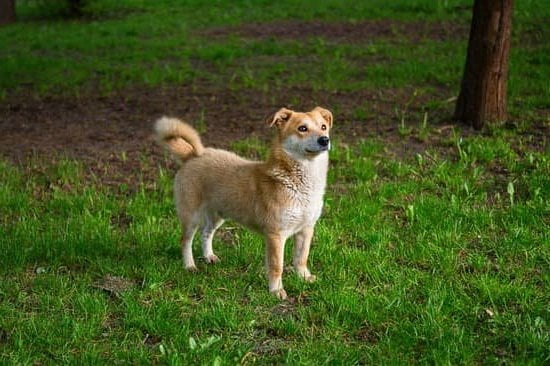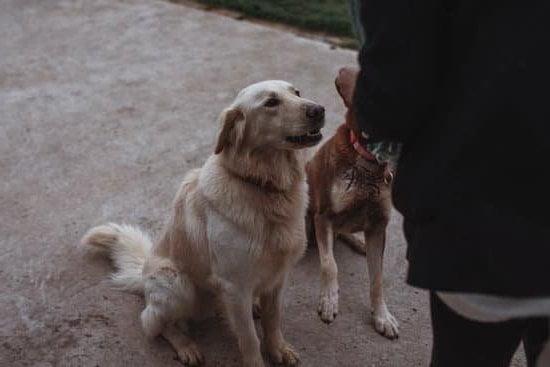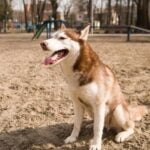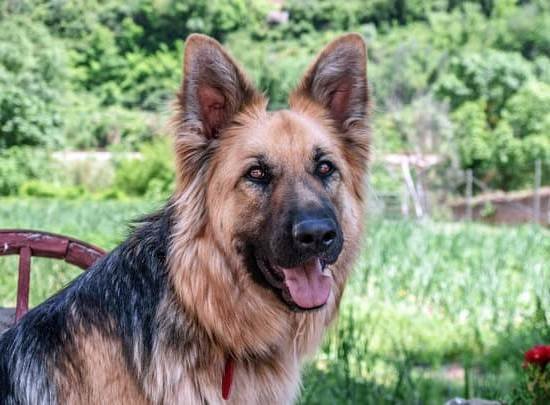Jumping behavior in dogs can be both frustrating and potentially harmful. It is crucial for pet owners to address this issue promptly and effectively in order to ensure the safety and well-being of their furry companions, as well as others around them.
In this article, we will explore how to train your dog from jumping on others, providing insights into why dogs exhibit this behavior, the negative consequences of allowing it to continue, and effective training techniques to address and eliminate jumping habits.
Understanding the root cause of why dogs jump on people is the first step towards addressing this behavior. Dogs may jump out of excitement, to seek attention, or as a way of establishing dominance.
Regardless of the reason behind it, allowing this behavior can lead to negative effects such as scratched skin, torn clothing, and even injuries – especially when dealing with larger breeds. It is essential for pet owners to implement training methods that discourage jumping in order to prevent potential accidents.
Basic training techniques such as ignoring your dog when they jump up, teaching them alternative behaviors like sitting or lying down when greeting people, and using verbal cues like “off” or “down” can be effective in curbing jumping behavior. Additionally, positive reinforcement through treats, toys, or praise can help reinforce desired behaviors while redirecting your dog’s energy in a positive way.
Consistency and patience are key components in successful training, along with addressing specific situations where jumping behavior occurs most frequently. By following these strategies and tips outlined in this article, pet owners can successfully train their dogs to stop jumping on others.
Understanding Why Dogs Jump on People
One of the common reasons why dogs jump on people is to seek attention. Dogs are social animals and jumping is their way of trying to engage with humans. They may have learned that jumping gets them the desired response, whether it’s a pat on the head or verbal praise.
Another reason for jumping behavior is excitement. When dogs are happy or excited, they may express this by jumping up on people. This is especially common when they greet their owners after being apart for some time or when meeting new people.
It’s also important to note that some dogs may jump out of anxiety or fear. They could be seeking reassurance or trying to establish a sense of control in uncertain situations. Understanding the underlying emotions behind your dog’s jumping behavior can help you address it effectively.
| Reasons for Jumping Behavior | Description |
|---|---|
| Attention Seeking | Dogs may jump to get attention from humans. |
| Excitement | Jumping can be a way for dogs to express happiness and excitement. |
| Anxiety/Fear | In some cases, dogs may jump due to feelings of anxiety or fear. |
The Negative Effects of Allowing Your Dog to Jump on Others
Allowing your dog to jump on others can have several negative effects, both for the person being jumped on and for the dog. It is important to understand these consequences in order to realize the significance of training your dog to stop this behavior. Here are some of the negative effects of allowing your dog to jump on others:
- Physical harm: Jumping dogs can accidentally scratch or knock over people, especially children or elderly individuals, causing physical harm.
- Reinforcement of dominant behavior: Allowing your dog to jump on others reinforces dominant behavior, which can lead to other behavioral issues down the line.
- Social discomfort: Not everyone appreciates being jumped on by a dog, which can create social discomfort and strain relationships with family, friends, and strangers.
By recognizing these negative effects, pet owners are more motivated to address and correct their dog’s jumping behavior through proper training techniques. It is crucial to teach your furry friend how to greet people calmly and respectfully without resorting to jumping.
Basic Training Techniques to Stop Jumping Behavior
When it comes to training your dog from jumping on others, consistency is key. Here are some basic training techniques that you can implement:
- Ignore the jumping behavior: Turn away or fold your arms when your dog jumps up, removing any attention as a way of discouraging the behavior.
- Use commands: Teach your dog commands like “sit” or “down” and reward them when they follow these commands instead of jumping.
- Practice greeting visitors: Enlist friends or family members to help practice greetings with your dog so they can learn appropriate behavior around guests.
These basic training techniques can help set a foundation for more advanced methods if necessary in addressing persistent jumping behavior in dogs. Remember that patience and consistency are vital in successfully training your pooch not to jump on others.
Basic Training Techniques to Stop Jumping Behavior
Dogs jumping on people can be an endearing behavior for some pet owners, but it can also become a nuisance and even a safety concern. Training your dog to stop jumping on others is essential to ensure good manners and prevent any potential accidents. In this section, we will discuss basic training techniques that you can use to curb this behavior effectively.
Setting Boundaries and Consistency
One of the fundamental steps in teaching your dog not to jump on people is to establish clear boundaries. Consistency is key when it comes to training your furry friend. Make sure everyone in your household or anyone who interacts with your dog follows the same rules regarding jumping behavior. This will help reinforce the training and avoid confusion for your pet.
Ignoring Jumping Behaviors
When your dog jumps on you or someone else, it’s crucial not to reward them with attention or affection, as this will only reinforce the behavior. Instead, ignore your dog by turning away or crossing your arms until they calm down. Once they have all four paws on the ground, you can then give them praise or a treat as positive reinforcement for obeying the command.
Teaching Alternative Behaviors
Redirecting your dog’s energy towards more appropriate behaviors can also help eliminate jumping tendencies. Teach them commands like “sit” or “down” and reward them when they listen. By providing an alternative action for your dog to perform when they feel excited or anxious, you can redirect their focus and prevent them from jumping on others impulsively.
Advanced Training Methods for Persistent Jumpers
Teaching Alternative Behaviors
For dogs who are persistent jumpers, it may be necessary to teach them alternative behaviors to replace jumping. One effective method is teaching your dog to “sit” or “stay” when meeting new people or in exciting situations. By training your dog to perform a different behavior instead of jumping, you can redirect their energy in a positive way. Consistency is key in reinforcing these alternative behaviors, so be sure to practice frequently and reward your dog for good behavior.
Utilizing Distraction Techniques
Another advanced training method for persistent jumpers is using distraction techniques to redirect their focus. For example, you can teach your dog to fetch a toy or perform a trick when they are tempted to jump on someone. By engaging your dog’s mind with an alternative activity, you can deter them from jumping on others. It’s important to recognize the signs that your dog is about to jump and intervene with a distraction before the behavior occurs.
Seeking Professional Help
If your dog continues to struggle with jumping behavior despite consistent training efforts, it may be beneficial to seek professional help from a certified dog trainer or behaviorist. These experts can provide personalized guidance and develop a tailored training plan for addressing your dog’s specific needs.
A professional trainer can also offer additional techniques and strategies for managing jumping behavior effectively. Remember, every dog is unique, so what works for one may not work for another – don’t hesitate to reach out for professional assistance if needed.
Using Positive Reinforcement in Dog Training
Training your dog to stop jumping on others can be a challenging task, but using positive reinforcement techniques can make a significant difference in your efforts. Positive reinforcement involves rewarding your dog for desired behaviors, such as sitting or staying calm when greeting someone, instead of focusing on punishing unwanted behaviors. When your dog learns that good behavior results in rewards, they are more likely to repeat that behavior in the future.
One effective way to use positive reinforcement in training your dog not to jump on others is to have treats readily available. When your dog approaches someone without jumping, immediately reward them with a treat and verbal praise. This helps your dog make the connection between staying calm and receiving a reward. Consistency is key when using positive reinforcement – make sure to reward your dog every time they exhibit the desired behavior.
In addition to treats, you can also use toys or a quick game of fetch as a reward for good behavior. Some dogs may be more motivated by playtime than food, so it’s essential to figure out what motivates your individual pet.
Remember that positive reinforcement is about encouraging and reinforcing the behaviors you want to see from your dog, rather than focusing on punishment for undesirable actions. By using this approach consistently, you can effectively train your dog to stop jumping on others in a friendly and gentle manner.
| Positive Reinforcement | Effective Training Technique |
|---|---|
| Rewarding with treats | Immediate rewards create positive associations |
| Using toys or playtime | Alternative rewards for different dogs’ motivations |
Tips for Consistency and Patience in Training
Consistency and patience are key factors in successfully training your dog to stop jumping on others. It is important to consistently enforce rules and boundaries, as well as to remain patient throughout the training process. Here are some tips to help you maintain consistency and patience in training your dog:
- Establish clear rules: Make sure everyone in the household is on the same page when it comes to training your dog. Consistency in enforcing rules will help reinforce the desired behavior.
- Set realistic expectations: Remember that changing a behavior takes time, so be patient with your dog. Set realistic goals and celebrate small victories along the way.
- Use positive reinforcement: Instead of punishing your dog for jumping, reward them for good behavior. Positive reinforcement can help motivate your dog to follow the rules and make training more enjoyable for both of you.
It is also important to be patient with your dog during the training process. Dogs learn at their own pace, so it is essential to give them time to understand what is expected of them. Remember that repetition and consistency are key components of successful training.
- Be patient with setbacks: Training a behavior change may not always go smoothly, but it’s essential to remain patient even when there are setbacks. Stay calm and continue working with your dog towards achieving the desired outcome.
- Take breaks when needed: If you or your dog are becoming frustrated during a training session, take a break and come back to it later. It’s okay to give yourselves some time to reset before continuing with the training.
- Stay consistent: Consistency is key in reinforcing new behaviors. Make sure everyone involved in caring for your dog follows the same rules and remains consistent in their approach to training.
By staying consistent in enforcing rules, setting realistic expectations, using positive reinforcement, and being patient with your dog, you can effectively train them to stop jumping on others. Your dedication and commitment will ultimately lead to success in modifying their behavior for the betterment of both you and your furry companion.
How to Redirect Your Dog’s Energy in a Positive Way
One effective way to prevent your dog from jumping on others is by redirecting their energy in a positive way. Dogs often jump on people out of excitement or as a way to get attention, so finding alternative outlets for their energy can help decrease this behavior.
One method is to engage your dog in physical activity such as playing fetch, going for walks, or participating in interactive games that stimulate both their mind and body. Regular exercise can help reduce excess energy and prevent your dog from resorting to jumping on others for stimulation.
Another way to redirect your dog’s energy is through mental stimulation. Training sessions, puzzle toys, and interactive feeding devices can provide mental challenges for your furry friend while keeping them occupied and engaged. By keeping your dog mentally stimulated, they are less likely to seek attention through jumping behaviors. Incorporating training exercises into daily routines not only helps redirect their energy but also strengthens the bond between you and your pet.
It’s important to remember that every dog is different, so it may take some trial and error to find the best ways to redirect your dog’s energy effectively. Observing your pet’s behavior patterns and experimenting with various activities can help determine what works best for them.
Consistency is key when implementing redirection techniques, so be patient and persistent in finding the right methods that suit your dog’s needs. By redirecting their energy positively, you can effectively discourage jumping behaviors and promote more acceptable ways for them to express themselves.
Addressing Specific Situations Where Jumping Behavior Occurs
Jumping behavior in dogs can occur in specific situations where they may feel excited, anxious, or simply seeking attention. It is essential for dog owners to address these specific situations to effectively train their canine companions to stop jumping on others. One common scenario where jumping behavior occurs is when guests visit your home. Dogs may jump on visitors out of excitement or to greet them, which can be overwhelming and even dangerous, especially for young children or elderly individuals.
To address jumping behavior when guests arrive, it is important to prepare your dog before the visitors enter your home. One effective technique is to teach your dog a “go to place” command, where they are trained to go to a specific spot, such as a mat or bed, when the doorbell rings or guests arrive.
By redirecting your dog’s focus and providing them with a clear instruction, you can prevent jumping behaviors and create a positive association with visitors.
Another specific situation where jumping behavior commonly occurs is during walks or outdoor activities. Dogs may jump on strangers, joggers, or other pets they encounter while out and about. To prevent this behavior, it is crucial to reinforce obedience training and practice proper leash-walking techniques.
Teaching your dog commands like “sit” or “stay” can help redirect their attention and curb their impulse to jump on others while on walks. Consistency and positive reinforcement are key in training your dog from jumping on others in various situations both inside and outside the home.
Case Studies and Success Stories in Training Dogs to Stop Jumping
Training your dog to stop jumping on others can be a challenging task, but with consistency, patience, and the right techniques, it is definitely achievable. By understanding why dogs jump on people in the first place and the negative effects of allowing this behavior to continue, you can take steps towards correcting it.
One of the basic training techniques to stop jumping behavior is teaching your dog alternative behaviors such as sitting or staying when greeting someone. Positive reinforcement is a powerful tool in dog training, so make sure to reward your dog for good behavior and ignore or redirect them when they jump. It’s important to be consistent in your training efforts and patient as it may take time for your dog to unlearn this habit.
For persistent jumpers, advanced training methods may be necessary such as using clicker training or seeking help from a professional trainer. Redirecting your dog’s energy in a positive way through exercise and mental stimulation can also help reduce their urge to jump.
Addressing specific situations where jumping behavior occurs, such as when guests come over or during walks, is crucial in modifying this behavior. With dedication and the right approach, you can successfully train your dog to stop jumping on others.
Frequently Asked Questions
How Do I Train My Dog Not to Jump on People?
Training your dog not to jump on people requires consistency and positive reinforcement. Encourage calm behavior by rewarding them when they greet someone without jumping. Redirect their attention to a more appropriate behavior, like sitting, whenever they start to jump.
How Do I Get My Dog to Stop Jumping on Other Dogs?
To prevent your dog from jumping on other dogs, focus on socializing them in controlled environments where you can supervise their interactions. Use positive reinforcement to reward calm and polite behavior around other dogs. Consistent training and patience are key in teaching them proper manners with fellow canines.
What Is the Best Command to Stop a Dog Jumping Up?
The “off” command is often used to stop a dog from jumping up on people or objects. Whenever your dog starts to jump, firmly say “off” and redirect their attention to a desired behavior, such as sitting or staying down. Consistency and positive reinforcement will help reinforce this command over time.

Welcome to the blog! I am a professional dog trainer and have been working with dogs for many years. In this blog, I will be discussing various topics related to dog training, including tips, tricks, and advice. I hope you find this information helpful and informative. Thanks for reading!





